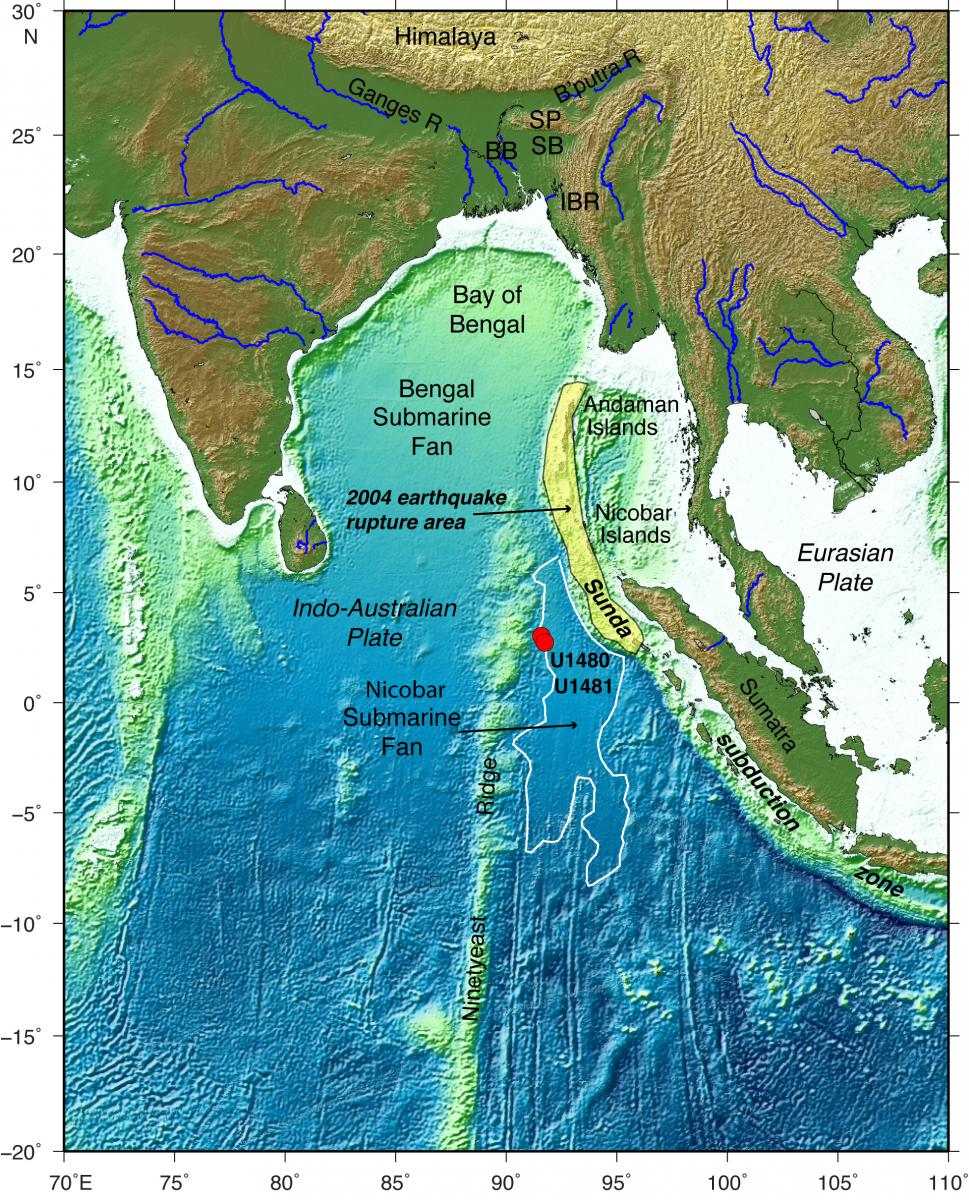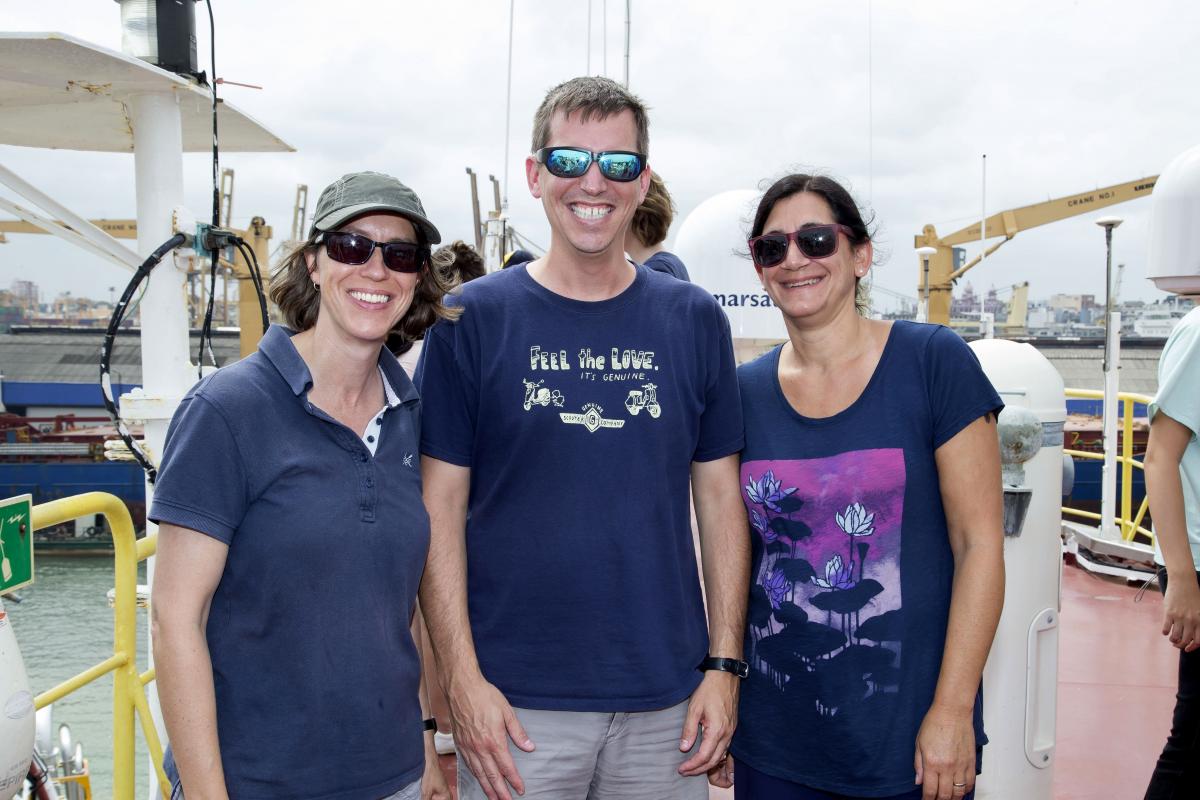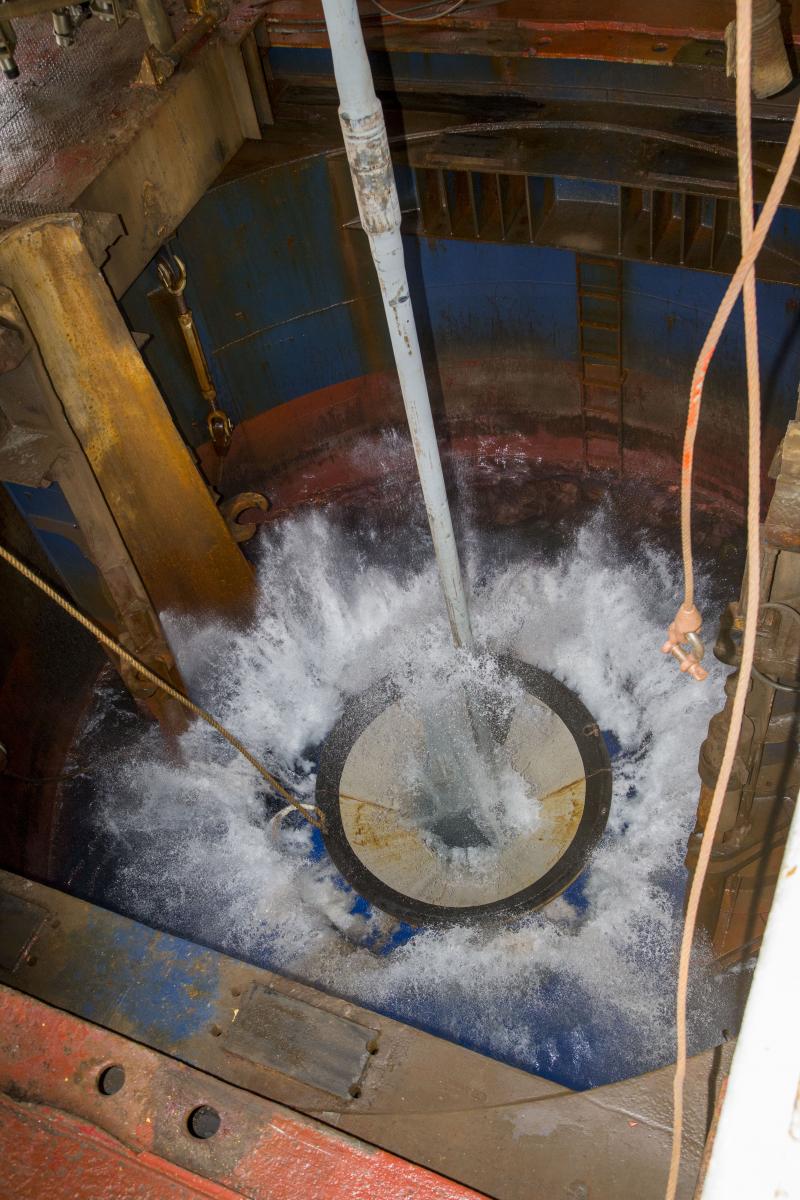 |
| Map of the eastern Indian Ocean and surrounding regions. The Indo-Australian plate was the source of the 2004 Sumatra earthquake and tsunami subducts beneath the Eurasian plate at the subduction zone (rupture area shaded in yellow). Ocean drilling boreholes are red dots (U1480, U1481). (Credit: Lisa McNeill, University of Southampton.) |
An international team of scientists has found evidence suggesting the dehydration of minerals deep below the ocean floor influenced the severity of the Sumatra earthquake, which took place on December 26, 2004, off the west coast of Indonesia.
The magnitude 9.2 earthquake and subsequent tsunami devastated coastal communities of the Indian Ocean, killing over 250,000 people.
Research into the earthquake was conducted during a scientific ocean drilling expedition to the region August through October 2016 as part of the International Ocean Discovery Program (IODP). Expedition 362 was led by researchers from Colorado School of Mines and the University of Southampton in collaboration with IODP scientist Katerina Petronotis.
On board the research vessel JOIDES Resolution, the researchers sampled, for the first time, sediments and rocks from the oceanic tectonic plate that feeds the Sumatra subduction zone. A subduction zone is an area where two of the Earth’s tectonic plates converge, one sliding beneath the other, generating the largest earthquakes on Earth, many with destructive tsunamis.
Findings of a study on sediment samples found far below the seabed are now detailed in a new paper authored by Dr. Andre Hüpers of the MARUM-Center for Marine Environmental Sciences at University of Bremen and published in the journal Science. Colorado School of Mines Associate Professor of Geophysics Brandon Dugan was one of the study’s coauthors and coleader of Expedition 362.
“It raised a lot of questions, because that wasn't a place in the world where we thought a magnitude 9 earthquake would occur,” said Dugan.
Expedition coleader Professor Lisa McNeill of the University of Southampton said “the 2004 Indian Ocean tsunami was triggered by an unusually strong earthquake with an extensive rupture area.” By unearthing the cause of such a large earthquake and tsunami, the scientists hope to be able to assess potential hazards in other regions with similar geological properties.
The scientists concentrated their research on a process of dehydration of sedimentary minerals deep below the ground, which usually occurs within the subduction zone. It is believed this dehydration process, which is influenced by the temperature and composition of the sediments, normally controls the location and extent of slip between the plates, and therefore the severity of an earthquake.
 |
| Expedition leaders from left: Lisa McNeill, Brandon Dugan, Katerina Petronotis. (Photo credit: Tim Fulton, IODP JRSO.) |
The Sumatra research team used the latest advances in ocean drilling to extract samples from 1.5 km below the seabed, taking measurements of sediment composition including chemical, thermal and physical properties.
At a certain depth, the researchers identified a layer where the water had lower salinity than the overlying and underlying sediment. This evidence of freshwater suggests that the water must have been released from within minerals in the sediment, as ocean water would have been high in salinity.
The researchers found that the sediments on the ocean floor, eroded from the Himalayan mountain range and Tibetan Plateau and transported thousands of kilometers by rivers on land and in the ocean, were subjected to geologic processes over millions of years. These sediments formed a sort of thick shell over minerals far below the seabed, causing chemical transformations within the subsurface.
 |
A 'free-fall funnel', part of the drilling process. |
These transformations caused the mineral bed to heat, pushing freshwater out of the mineral crystals up through the sediment layers.
At first, this water would have softened the sediment, actually decreasing the risk of a big earthquake by allowing it to absorb more force, Dugan explained. However, as the sediment moved closer to the fault over millions of years, the water flowed away, leaving the sediment dehydrated and brittle—the perfect setup for a megaquake.
The scientists ran simulations to calculate how the Sumatra sediments (currently not yet to the fault) would behave once they had traveled 250 km to the east toward the subduction zone and been buried significantly deeper. The simulations showed the sediment reaching higher temperatures, thus supporting their findings.
Hüpers said that the findings suggest that other subduction zones with thick and hotter sediment and rock could also experience this phenomenon.
“The 2004 Sumatra and 2011 Tohoku earthquakes made us reexamine our understanding of large earthquakes,” said Dugan. “This new analysis extends our knowledge of the conditions that can contribute to large earthquakes that generate tsunamis. We now can assess the potential for megaquakes in subduction margins with limited or no historical earthquake record.”
Subduction zone earthquakes typically have a return time of a few hundred to a thousand years, so applying this research to similar geological regions will allow scientists to better predict these hazards.
Similar subduction zones exist in the Caribbean (Lesser Antilles), off Iran and Pakistan (Makran), and off the western United States and Canada (Cascadia). The team will continue research on the samples and data obtained from the Sumatra drilling expedition over the next few years, including laboratory experiments and further numerical simulations, and will use their results to assess the potential future hazards both in Sumatra and at these comparable subduction zones.



